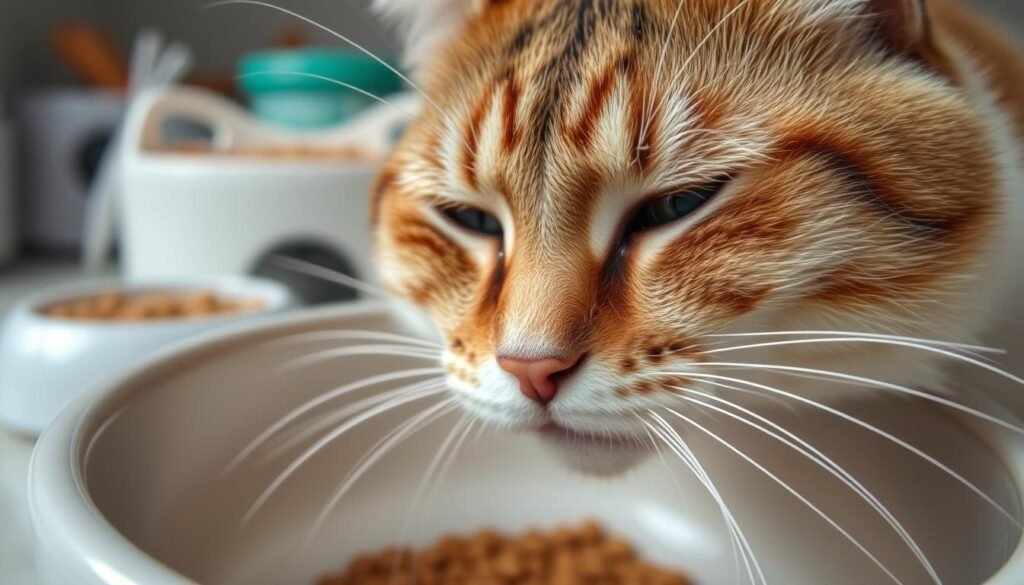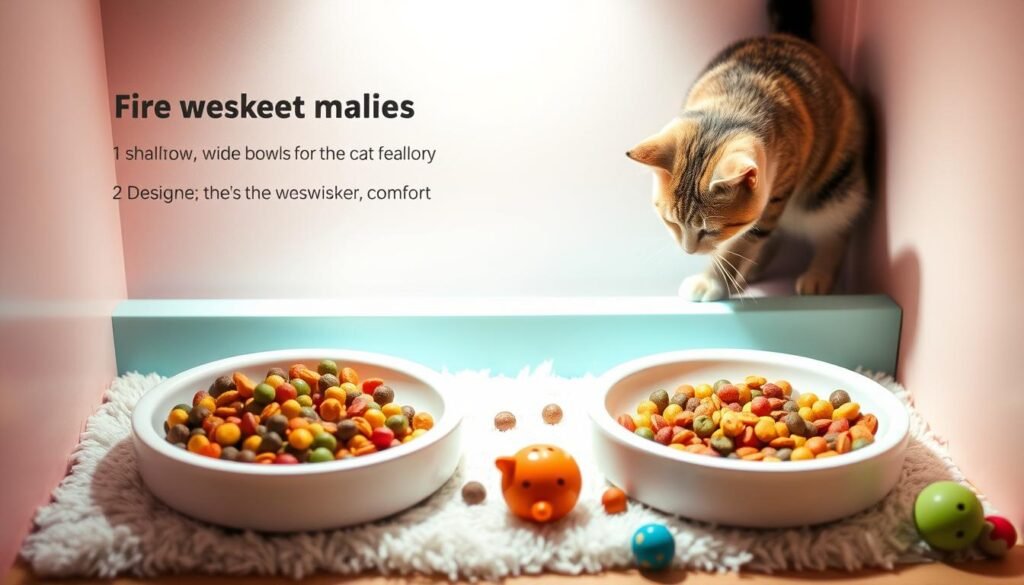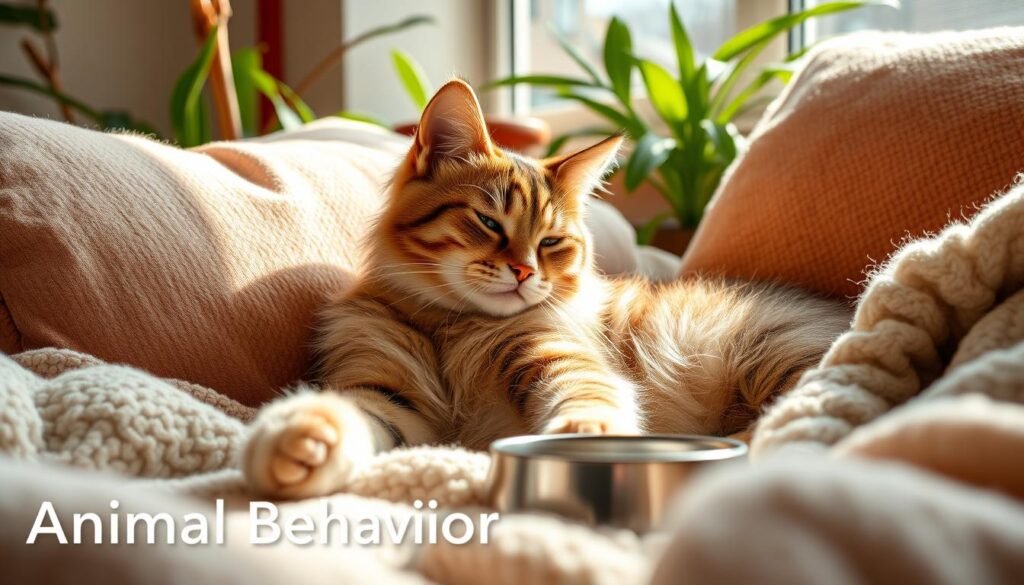Over 50% of cat owners have noticed their pets show signs of whisker fatigue. This issue, called whisker stress by vets, highlights the importance of understanding how cats feel. Whisker fatigue happens when cats get uncomfortable from too much touching of their sensitive whiskers, especially when they eat.
Knowing about this condition helps pet owners make mealtime better for their fur babies. Choosing the right feeding accessories is key. Wide, shallow bowls help avoid whisker discomfort. Many cat owners find that their pets eat better with these dishes. This leads to happier, more at ease cats at meal times.
By making small changes, like using whisker-friendly dishes, cat lovers can boost their pet’s happiness. Learning about whisker fatigue is essential for keeping cats joyful and in good health.
Key Takeaways
- Whisker fatigue is also known as whisker stress.
- Choosing whisker-friendly bowls can prevent whisker fatigue during mealtimes.
- Signs of whisker fatigue include cautious eating and avoiding food at the bottom of deep bowls.
- Avoiding deep and narrow bowls can significantly enhance cat comfort.
- Discuss any concerning eating behaviors with a veterinarian to rule out health issues.
Understanding Cat Whiskers
Cat whiskers, or feline vibrissae, are not just cute. They are specialized hairs deep in the cat’s skin. They help cats understand where they are and move around. Knowing about cat whiskers helps us understand how cats see the world.
What Are Cat Whiskers?
Cat whiskers are thick, sensitive hairs. They act like touch sensors. These hairs are full of nerve endings. They send information to the cat’s brain, helping it know about distances, movement, and changes around it. This is crucial for their survival. It helps them in hunting, exploring, and moving safely.
The Role of Whiskers in Cat Behavior
Whiskers are like tiny antennas for cats. They help cats know their space and move through tight spots. Cats use their whiskers to check if they can fit through small openings.
Whiskers also show a cat’s mood and what it plans to do. They are key in how cats communicate with others. It’s important for a cat’s whiskers to not get too stimulated. Too much stimulation can make a cat stressed. To find out more about this, check out whisker fatigue in cats.
What Is Whisker Fatigue?
Whisker fatigue, also known as whisker stress, affects a cat’s comfort and actions a lot. It happens when a cat’s whiskers touch surfaces too much, causing too much sensation. For cat owners, it’s key to understand whisker fatigue to make their pet’s life better.
Defining Whisker Fatigue
Whisker fatigue comes when a cat’s whiskers keep hitting deep bowls or other stuff. Whiskers are very important for sensing, so this can upset and stress them. Signs like not eating well may show they’re feeling this stress from their whiskers.
The Theory Behind Whisker Fatigue in Cats
The idea is a cat’s whiskers are super sensitive and get too much info can stress them out. Cats dealing with this might be wary around their food bowls, not finish their meals, or ignore food left in their bowls. Using bowls that are shallow and wide can make eating less stressful for them.
Is Whisker Fatigue Real?
Whisker fatigue is a topic that has caught the eye of cat lovers and vets. It’s important to look at different viewpoints and research to take good care of cats. While some vets believe whisker fatigue affects cats, others are not so sure. As more people become interested, it’s important to find trustworthy information. This helps make smart choices for pet care.
Veterinary Perspectives
Vets suggest looking closely at how cats act and their living spaces. They say whisker stress can change how cats deal with their world, especially when eating. Whiskers are sensitive and help cats move around and know where things are. If these whiskers touch the sides of deep bowls, it can bother cats. This might make them eat in certain ways that show they’re uncomfortable.
Studies and Findings on Whisker Fatigue
Studies on whisker fatigue show different results, which means more research is needed. A study in 2020 looked at how bowl shapes affect how cats eat. It found cats liked some bowls more, but eating habits didn’t really change. This keeps the debate on whisker fatigue going. It makes us wonder how each cat’s own experiences and their surroundings affect their well-being.
Talking about cat health includes whisker fatigue, to help owners choose the right bowls. It’s key to notice how cats act around their food, like if they’re careful or leave food behind. This could point to problems. Cats that are younger or have had stress before might feel more worried when eating. Raising awareness about whisker fatigue helps make eating better for cats and keeps them happy and healthy.
Causes of Whisker Fatigue in Cats
Whisker fatigue, or stress in cats, comes from common items in their environment. It’s crucial for owners to know what causes this. A main cause is deep bowls. They can overwhelm a cat’s senses when their whiskers touch the sides while they eat or drink.
Everyday Items That Trigger Whisker Fatigue
Household items can cause whisker fatigue in cats. Notably, these include:
- Food bowls that are too deep.
- Narrow water dishes.
- Containers with high sides.
This frequent contact leads to stress in cats. This shows as cautious behavior or even avoiding eating. Removing these triggers is key for their comfort.
The Impact of Deep Bowls on Cat Whiskers
Deep bowls don’t allow cats to eat comfortably. This causes frustration and discomfort. Cats may eat from the ground, showing the bowl is the problem.
To fix whisker fatigue, use wide, flat bowls. These prevent whisker contact with the sides. It helps cats eat better and improves their well-being.

Signs of Whisker Fatigue in Cats
It’s crucial to spot the signs of whisker fatigue in cats. They show different behaviors when they have it. As a pet owner, knowing these signs can help keep your cat happy and comfortable.
Behavioral Indicators to Watch For
Watch for certain cat behavior indicators that suggest whisker fatigue. These signs include being cautious around food bowls and leaving food uneaten. They might also paw food onto the floor or act aggressive during meals. Lastly, shaking their head after eating is a common sign.
- Cautious approaches to food bowls
- Leaving food uneaten or acting hungry
- Pawing at food to move it onto the floor
- Exhibiting aggression during mealtime
- Shaking their head frequently after eating
Remember, these symptoms might not only mean whisker fatigue. They could signal other issues too, so stay aware.
How to Differentiate Whisker Fatigue from Other Issues
To tell if it’s whisker fatigue or something else, watch your cat’s behavior closely. Not wanting to eat or being messy with food could also be dental issues or stress. If these eating habits seem odd, it’s best to see a vet.
Making a switch to whisker-friendly bowls helps stop whisker fatigue. These bowls ensure whiskers don’t get irritated at meal times. By being attentive and proactive, pet owners can make meal times better for their cats.
The Connection Between Cat Whiskers and Sensory Overload
To understand sensory overload in cats, we must look at their whiskers. They act as high-tech sensory tools. These aren’t just for looks; they play a key role in how cats sense the world. Rooted deep in the cat’s skin, these whiskers are hooked to their muscles and nerves. This makes them super sensitive to the environment.
Understanding Sensory Overload in Felines
Sensory overload happens when cats get too much information at once, causing stress. It can be loud noises or meeting new animals. Their whiskers help them understand space and avoid bumping into things. The whiskers’ length matches the cat’s body width. This helps them figure out if they can squeeze through small spots.
How Whiskers Serve as Sensory Antennas
As a cat moves, its whiskers pick up vital info about nearby objects. This skill is essential for hunting, letting cats sense even tiny movements. It helps them catch prey with precision. However, too much stimulation can tire their whiskers out. This is called whisker fatigue, making it hard for them to eat or drink. Using wide, flat bowls can help avoid this by keeping their whiskers free from touching the sides.
| Whisker Function | Impact on Cats |
|---|---|
| Environment Scanning | Helps avoid obstacles and navigate spaces |
| Hunting Assistance | Detects movement for precise prey capture |
| Space Assessment | Indicates if the cat can fit through openings |
| Situational Awareness | Contributes to overall sensory information gathering |
| Whisker Fatigue Risk | Overstimulation can lead to stress and discomfort |
Pet Grooming Needs Related to Whisker Fatigue
Grooming is key to keeping your cat happy and healthy. It tackles problems like whisker fatigue. By knowing grooming effects on cat comfort, you can stop issues before they start. Grooming cuts down on loose fur. It also keeps the facial hair neat, easing the strain on sensitive whiskers.
Effect of Grooming on Cat Comfort
Grooming makes cats comfy and eases their stress. Regular brushing gets rid of dirt and tangles. This stops skin and whisker irritation. A clean cat means less sensory overload. So, their comfort goes up and whisker fatigue risks go down.
Recommendations for Cat Grooming Practices
Here are tips to groom your cat right and fight whisker fatigue:
- Brush often to avoid knots and keep the fur clean.
- Never trim the whiskers—it can harm their senses.
- Introduce grooming slowly to keep your cat calm.
- Choose cat-specific tools for more comfort and effectiveness.
Following these steps, you can greatly help your cat feel better. Knowing how grooming affects them leads to smarter care practices. This ensures your cat’s comfort and health.
Visit here for more insights on preventing whisker fatigue
Addressing Whisker Fatigue at Home
Finding ways to alleviate whisker fatigue can greatly improve a cat’s mealtime. The first step is selecting the right feeding bowls. Whisker-friendly bowls are wide and shallow, giving cats the space to eat without stress.
Choosing Whisker-Friendly Bowls
Choosing the right bowl is key for whisker fatigue. Look for options that are gentle on a cat’s whiskers. This makes mealtime more enjoyable and less stressful. Avoid deep dishes that can bother your cat. Instead, choose bowls with a flat base and wide space. Today, many bowls are made just for this, helping pet owners find the right fit.
Setting Up a Comfortable Feeding Environment
Creating a comfortable feeding place is also important for whisker fatigue. A clear, calm spot makes a big difference. This reduces stress and makes mealtime relaxing. Make sure your cat’s feeding area is quiet and welcoming. This supports their health and improves their eating experience.

What If the Problem Isn’t Whisker Fatigue?
If whisker fatigue isn’t the issue, we need to look into other health problems. These might seem similar to whisker fatigue. Issues like dental diseases, liver problems, or stomach concerns can show similar signs. Since cats often hide their pain, it’s important for owners to watch their pets closely.
Common Health Issues with Similar Symptoms
Several health issues can show the same signs as whisker fatigue. This can make it hard to figure out what’s really wrong with your cat. Problems that might get confused with whisker fatigue include:
- Dental Diseases: Cats might not eat well if they have mouth pain or swelling, which looks a lot like whisker fatigue.
- Liver Disease: This problem can make a cat very tired and eat less, which might seem like they’re tired of whisker contact.
- Gastrointestinal Issues: Stomach troubles can lead to odd eating habits, similar to signs of whisker fatigue.
The Importance of Veterinary Advice
Knowing the difference between whisker fatigue and other problems is key. Spotting the early signs of trouble can really help. It’s important to get advice from a vet to figure out the issue and how to treat it. This can stop a cat’s health from getting worse.
It’s important to take your cat to the vet regularly. This is especially true if you notice any changes in how they act or eat. Staying alert to these changes helps you understand your cat’s health better. This leads to better care for them.
| Condition | Similar Symptoms | Recommended Actions |
|---|---|---|
| Dental Diseases | Avoiding food, pawing at mouth | Vet examination, dental cleaning |
| Liver Disease | Lethargy, decreased appetite | Regular blood tests, dietary modifications |
| Gastrointestinal Issues | Vomiting, changes in behavior | Diet evaluation, possible medication |
Animal Behavior Understanding and Whisker Fatigue
It’s important for pet owners to understand their cats’ behaviors. This helps create a loving environment for them. Whisker fatigue, for instance, can really affect how comfortable cats feel, especially around mealtime. Signs like not wanting to eat or getting upset with other pets can mean they’re not comfortable. These signals are crucial for owners to notice. They show it’s time to make things better for their furry friends.
Insights into Feline Behavior
Whisker fatigue happens when a cat’s whiskers get overstimulated. This makes them stressed out around their food bowls. You might see signs like cats knocking food out of their bowls or being grumpy when they eat. Understanding these signs is key. It helps owners take the right steps to help their cats feel better. Paying attention to these behaviors can make a big difference in a cat’s happiness.
The Importance of Pet Owner Awareness
Knowing about whisker fatigue is key for pet owners. There are special bowls that can help, like the wide, shallow ones from Americat Company. These bowls stop whiskers from getting squished, which makes mealtime nicer for cats. Keeping the eating area clean also helps keep cats comfy and healthy. When owners focus on these things, cats can really enjoy their meals. This leads to happier, healthier pets.

Conclusion
Whisker fatigue is a big concern for cat well-being. It involves the discomfort cats feel from their sensitive whiskers. This happens when they touch things like food and water bowls.
Pet owners can spot signs of this issue. Look for changes in behavior or signs of stress in cats. Understanding whisker fatigue helps in noticing these signs.
Creating a cat-friendly space helps a lot. Use bowls that are wide and not too deep. This can make your cat’s life much better.
This not only helps with whisker fatigue. It also leads to better eating and drinking habits. So, our furry friends lead healthier lives.
But learning about cat care doesn’t stop with whisker fatigue. Keep an eye out for other health issues. And don’t forget regular check-ups with the vet.
As we learn more about whisker fatigue, our commitment grows. We aim to improve the lives of our cats. And ensure they are happy and comfortable.